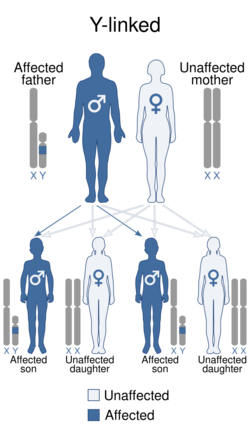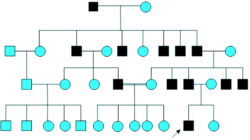Biology:Y linkage
Y linkage, also known as holandric inheritance (from Ancient Greek ὅλος hólos, "whole" + ἀνδρός andrós, "male"),[1] describes traits that are produced by genes located on the Y chromosome. It is a form of sex linkage.
Y linkage can be difficult to detect. This is partly because the Y chromosome is small and contains fewer genes than the autosomal chromosomes or the X chromosome. It is estimated to contain about 200 genes. Earlier, the human Y chromosome was thought to have little importance;.[2] Although the Y-chromosome is sex-determining in humans and some other species, not all genes that play a role in sex determination are Y-linked. The Y-chromosome, generally does not undergo genetic recombination and only small regions called pseudoautosomal regions exhibit recombination. The majority of the Y-chromosome genes that do not recombine are located in the "non-recombining region".[3]
For a trait to be considered Y linkage, it must exhibit these characteristics:
- occurs only in males
- appears in all sons of males who exhibit that trait
- is absent from daughters of trait carriers; instead the daughters that are phenotypically normal and do not have affected offspring.[4]
These requirements were established by the pioneer of Y linkage, Curt Stern. Stern detailed in his paper genes he suspected to be Y-linked.[4] His requirements at first made Y linkage hard to prove. In the 1950s using human pedigrees, many genes were incorrectly determined to be Y-linked.[5] Later research adopted more advanced techniques and more sophisticated statistical analysis.[6] Hairy ears are an example of a gene once thought to be Y-linked in humans; however, that hypothesis was discredited.[5] Due to advancements in DNA sequencing, Y linkage is getting easier to determine and prove. The Y-chromosome is almost entirely mapped, revealing many Y-linked traits.
Y linkage is similar to, but different from X linkage; although, both are forms of sex linkage. X linkage can be genetically linked and sex-linked, while Y linkage can only be genetically linked. This is because males' cells have only one copy of the Y-chromosome. X-chromosomes have two copies, one from each parent permitting recombination. The X chromosome contains more genes and is substantially larger.
Some ostensibly Y-linked traits have not been confirmed. One example is hearing impairment. Hearing impairment was tracked in one specific family and through seven generations all males were affected by this trait. However, this trait occurs rarely and has not been entirely resolved.[7]
Y-chromosome deletions are a frequent genetic cause of male infertility.
Animals
Guppies
In guppies, Y-linked genes help determine sex selection. This is done indirectly by traits that allow the guppy to appear more attractive to a prospective mate. These traits were shown to be on the Y-chromosome and thus Y-linked.[8] Also in guppies, it appears that the four measures of sexual activity is Y-linked.[9]
Rats
Hypertension, or high blood pressure, appears to be Y-linked in the hypertensive rat. One loci was autosomal. However, the second component appeared to be Y-linked. This held through the third generation of rats. Male offspring with a hypertensive father had significantly higher blood pressure than male offspring with a hypertensive mother indicating that a component of the trait was Y-linked. The results were not the same in females as in males, further hinting at a Y-component.[10]
Hairy ears
Hairy ears were thought to be a Y-linked trait,[11] but this was disproven.[5]
Genes known to be contained on the human Y chromosome
In general, traits that exist on the Y chromosome are Y-linked because they only occur on that chromosome and do not change in recombination.
As of 2000, a number of genes were known to be Y-linked, including:[12]
- ASMTY (acetylserotonin methyltransferase),
- TSPY (testis-specific protein),
- IL3RAY (interleukin-3 receptor),
- SRY (sex-determining region),
- ZFY (zinc finger protein),
- PRKY (protein kinase, Y-linked),
- AMELY (amelogenin, Y-linked),
- ANT3Y (adenine nucleotide translocator-3 on the Y),
- AZF2 (azoospermia factor 2),
- BPY2 (basic protein on the Y chromosome),
- AZF1 (azoospermia factor 1),
- DAZ (Spermatogenes is deleted in azoospermia),
- RBM1 (RNA binding motif protein, Y chromosome, family 1, member A1),
- RBM2 (RNA binding motif protein 2), and
- UTY (ubiquitously transcribed TPR gene on Y chromosome).
- USP9Y
See also
- Genetic linkage
- Sex linkage
- X linkage
References
- ↑ "Definition of holandric | Dictionary.com" (in en). https://www.dictionary.com/browse/holandric.
- ↑ Sayres, Wilson (2012). "Gene survival and death on the human Y chromosome.". Mol Biol Evol 30 (4): 781–87. doi:10.1093/molbev/mss267. PMID 23223713.
- ↑ Skaletsky, Helen (2003). "The male-specific region of the human Y chromosome is a mosaic of discrete sequence classes". Nature 423 (6942): 825–837. doi:10.1038/nature01722. PMID 12815422. Bibcode: 2003Natur.423..825S.
- ↑ 4.0 4.1 Curt, Stern (1957). "The Problem of Complete Y-Linkage in Man". American Journal of Human Genetics 9 (3): 147–166. PMID 13469791.
- ↑ 5.0 5.1 5.2 Lee, Andrew (2004). "Molecular evidence for absence of Y-linkage of the Hairy Ears trait". European Journal of Human Genetics 112 (12): 1077–1079. doi:10.1038/sj.ejhg.5201271. PMID 15367914.
- ↑ Ott, J (1986). "Y-linkage and pseudoautosomal linkage". Am J Hum Genet 38 (6): 891–7. PMID 3728465.
- ↑ Wang, Qiuju (2013). "Genetic Basis of Y-Linked Hearing Impairment". Am J Hum Genet 92 (2): 301–6. doi:10.1016/j.ajhg.2012.12.015. PMID 23352258.
- ↑ Postma, Erik (2011). "Sex-Dependent Selection Differentially Shapes Genetic Variation on and off the Guppy y Chromosome". Society for the Study of Evolution 65 (8): 2145–2156. doi:10.1111/j.1558-5646.2011.01314.x. PMID 21790565.
- ↑ Farr, James (1983). "The Inheritance of Quantitative Fitness Traits in Guppies, Poecilia reticulata". Evolution 37: 1193–1209. doi:10.2307/2408841.
- ↑ Ely, D. (1990). "Hypertension in the spontaneously hypertensive rat is linked to the Y chromosome". American Heart Association 16 (3): 277–281. doi:10.1161/01.hyp.16.3.277. PMID 2394486.
- ↑ Stern, Curt (1964). "New Data on the Problem of Y-Linkage of Hairy Pinnae". Am J Hum Genet 16 (4): 455–71. PMID 14250426.
- ↑ "Y-linked gene definition - Medical Dictionary: Definitions of Popular Terms Defined on MedTerms". Medterms.com. 2012-09-20. http://www.medterms.com/script/main/art.asp?articlekey=15745.
External links
- Y-linked Genetic Diseases at wrongdiagnosis.com
- http://learn.genetics.utah.edu/content/pigeons/sexlinkage/
- http://www.livestrong.com/article/74388-y-linked-genetic-diseases/
- http://www.medicinenet.com/script/main/art.asp?articlekey=15729
- https://www.ncbi.nlm.nih.gov/books/NBK22266/#A296
- http://learn.genetics.utah.edu/content/pigeons/geneticlinkage/
±
 |



